Symmetrical Front Garden Ideas: Transform Your Yard into a Balanced Oasis
Creating a symmetrical front garden can enhance the curb appeal of your home, making it look welcoming and well-organized. Whether you prefer a traditional or modern style, symmetry can bring balance and harmony to your garden design.
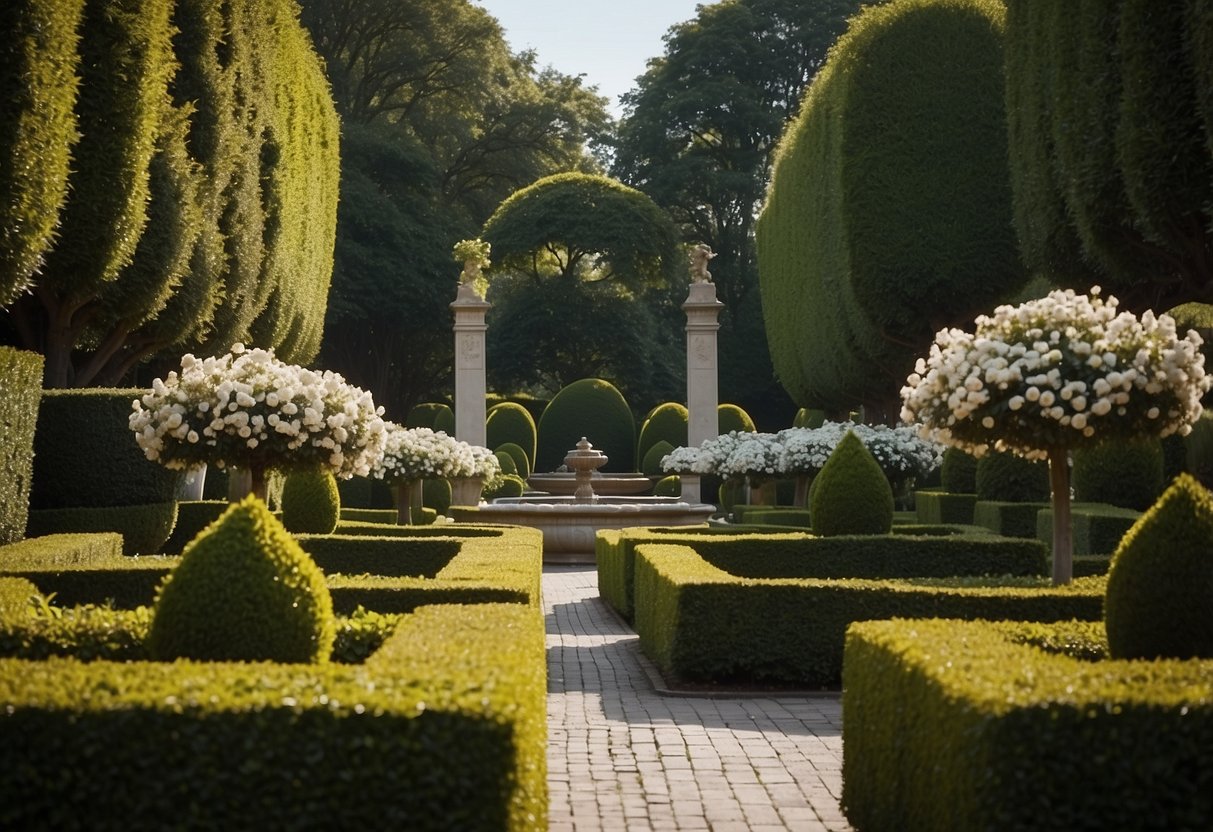
How do you achieve a beautiful and balanced front yard with symmetry? We’ll explore a variety of ideas that cater to different tastes and preferences, providing inspiration for you to create a stunning entrance to your home.
1) Geometrical Hedge Patterns

Adding geometrical hedge patterns to your front garden can create a striking visual effect. Straight lines and sharp angles make a space feel organized and elegant.
Think about designing with squares, rectangles, or even circles. Using these shapes can guide the eye and create focal points.
For example, you could line pathways with rectangular hedges to emphasize symmetry and order, echoing traditional formal garden styles.
Incorporating small, evergreen hedges can help frame perennials and add a sense of structure, enhancing the overall appearance.
2) Symmetrical Flower Beds
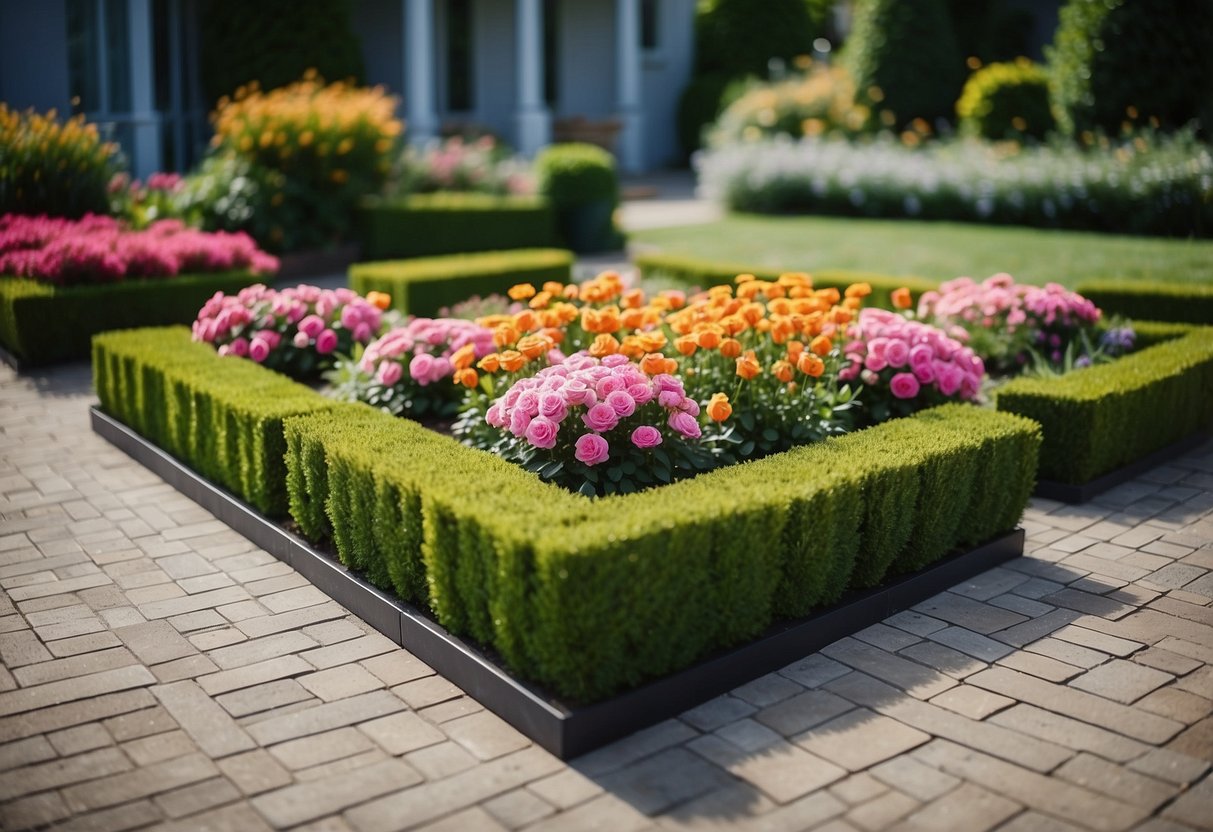
Symmetrical flower beds create a balanced and pleasing visual effect in your garden. By mirroring the same plants on each side, you can achieve a neat and orderly look that is easy on the eyes.
Use red clay bricks or natural stone to edge your flower beds. These materials add charm and help keep your plants tidy.
Incorporate plants of varying heights and textures to maintain interest. For example, ferns, hostas, and ornamental grasses bring depth and beauty to the symmetrical layout.
Careful pruning is essential to keep the mirror image intact. Regular maintenance keeps your garden looking sharp and balanced.
3) Perfectly Aligned Pathways
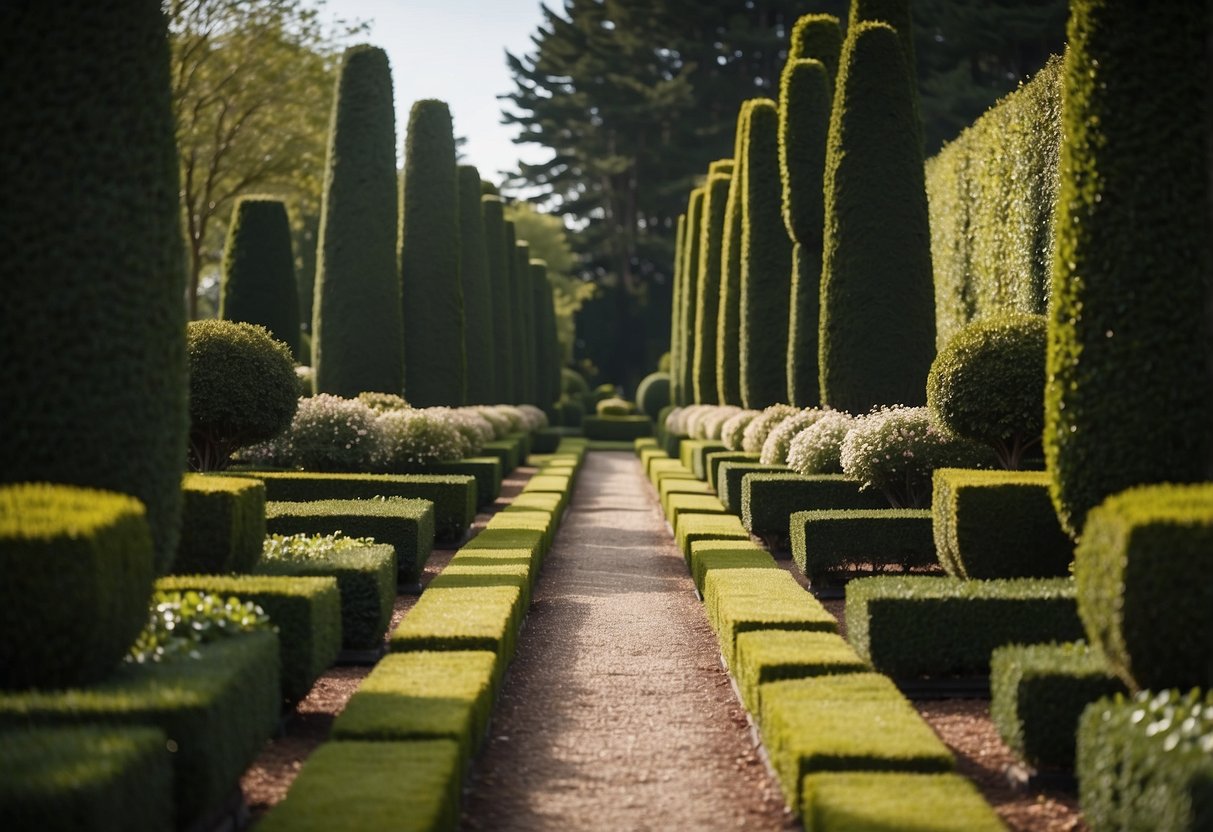
Creating a pathway that is perfectly aligned can make your front garden look neat and organized. By using the same plants on each side, you can create a sense of balance and symmetry.
Wide pathways can add grandeur and make your front yard feel welcoming. Consider paths that are about 5 to 6 feet wide for a special touch.
Using grass pathways lined with plants can also enhance symmetry without needing extra materials like stones or gravel. This simple approach can be very effective and elegant.
4) Pair of Stone Statues

A pair of stone statues can add a touch of elegance to your front garden. These statues give a timeless appeal and can be placed on either side of a pathway or entrance for a balanced look.
Stone statues come in various designs, from classical figures to modern art pieces. Choose something that matches the style of your home and garden.
Consider the height and size of the statues. They should be large enough to make an impact but not so big that they overwhelm the space.
5) Mirror Image Shrubs

Using mirror image shrubs is a fantastic way to add symmetry to your garden. Place identical shrubs on either side of an entryway or path.
Make sure the shrubs are pruned regularly to maintain their shape and balance.
This approach works well with evergreen hedges or topiary shapes, giving a clean and organized look to your space.
For more tips, check out these ideas on designing with plant symmetry.
6) Balanced Water Features
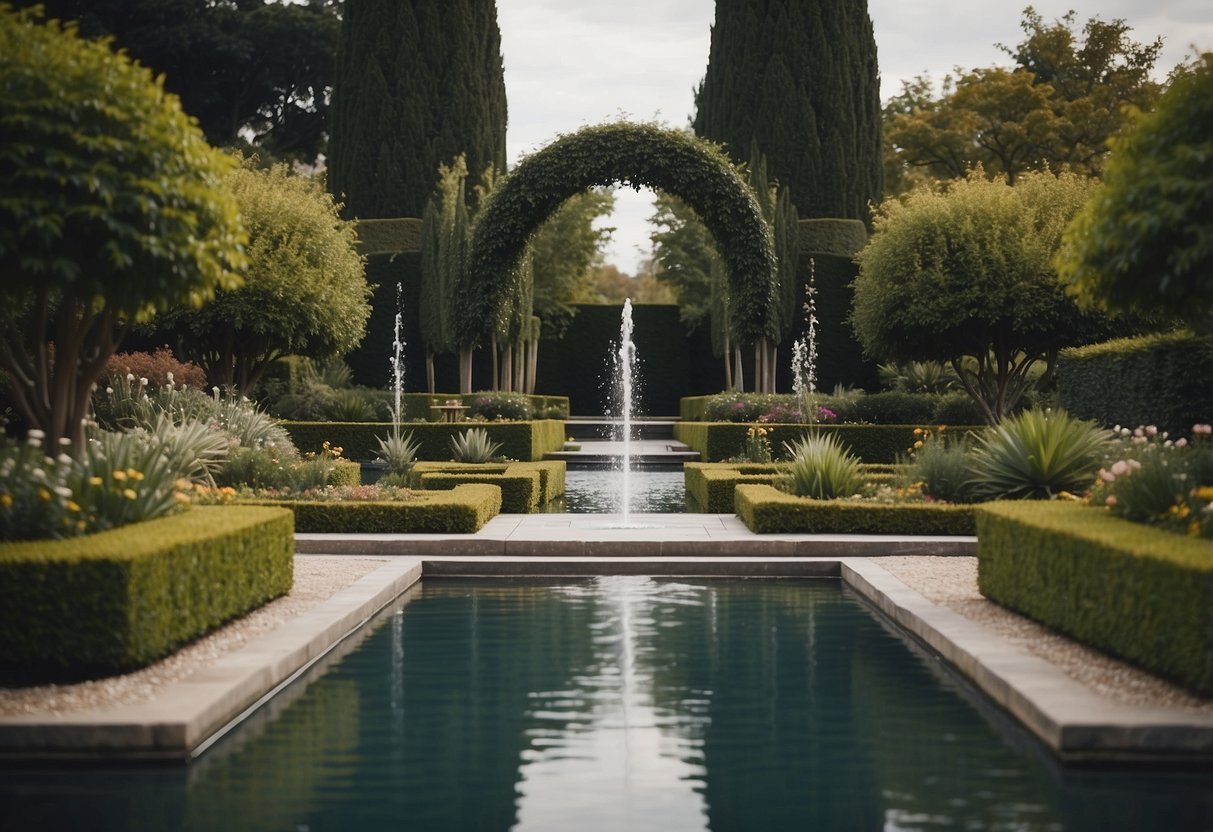
Balanced water features can add a sense of tranquility to your front garden.
A symmetrical placement of fountains or birdbaths on either side of a path creates harmony.
A concrete fountain carved from stone can be a striking centerpiece.
7) Dual Garden Benches

Adding dual garden benches to your front yard can create a welcoming and serene space.
Place the benches symmetrically on either side of a garden path or a focal point like a water feature. This setup enhances the balanced look of your garden.
You can also use creative benches that match your garden’s theme. For a modern touch, consider benches made from materials like Corten steel or aluminum, as highlighted in Bob Vila’s ideas.
8) Twin Bird Baths
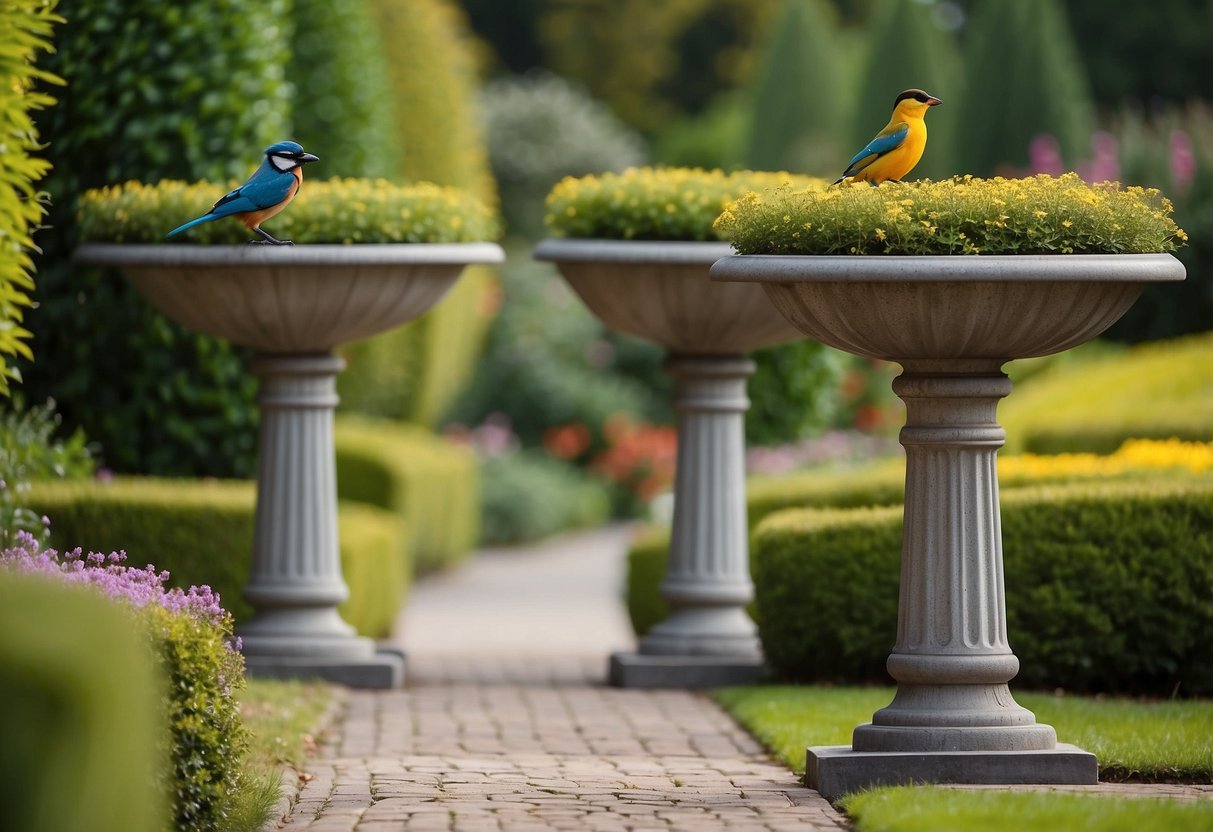
Adding twin bird baths can enhance the symmetry of your front garden. Place them on either side of a central path or entryway to create a balanced look.
You can choose decorative designs like a Stone Fiberclay Bird Bath or even create your own with a DIY Vase and Wood Slice Bird Bath. This not only attracts birds but also adds a charming focal point to your garden.
9) Evenly Spaced Topiaries
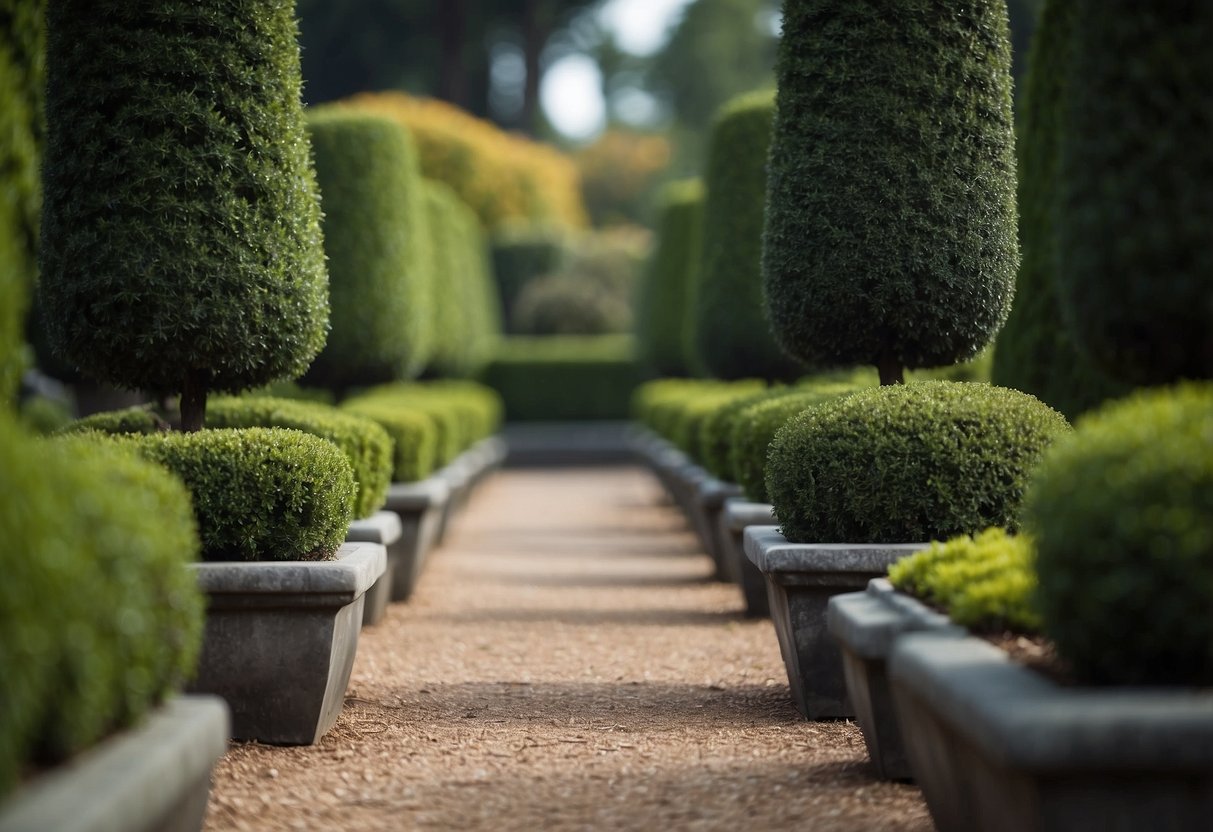
Evenly spaced topiaries create a clean and organized look for your front garden. These green sculptures can enhance the symmetry of your space.
You can line up your pathway with small, round topiaries for a neat appearance. They can also be placed on either side of your garden gate to add a touch of elegance.
Square or geometric shapes work well for formal designs. Their structured look can make your front yard appear larger and more orderly. Try incorporating different styles of topiaries to suit the overall aesthetic of your home. Check out these ideas from DigsDigs for more inspiration.
10) Symmetrical Garden Lights
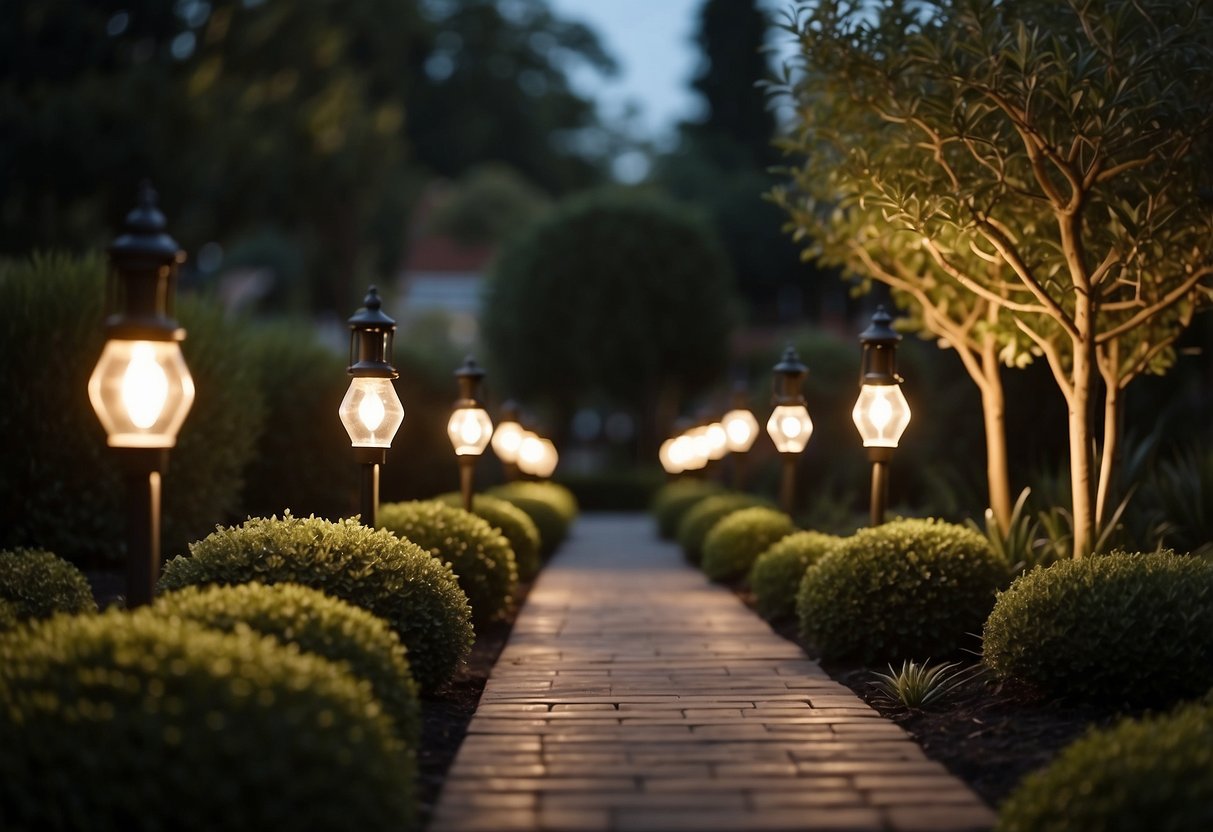
Symmetrical garden lights can create a balanced and harmonious look in your front yard. Placing lights evenly on both sides of a path or driveway adds a touch of elegance and clarity.
Consider using globe-shaped lights for a modern look.
Lights under the eaves of the porch can enhance both functionality and aesthetic at night. You can also set spotlights behind plants to highlight them beautifully. These simple touches can make a huge difference.
Fundamentals of Symmetrical Garden Design
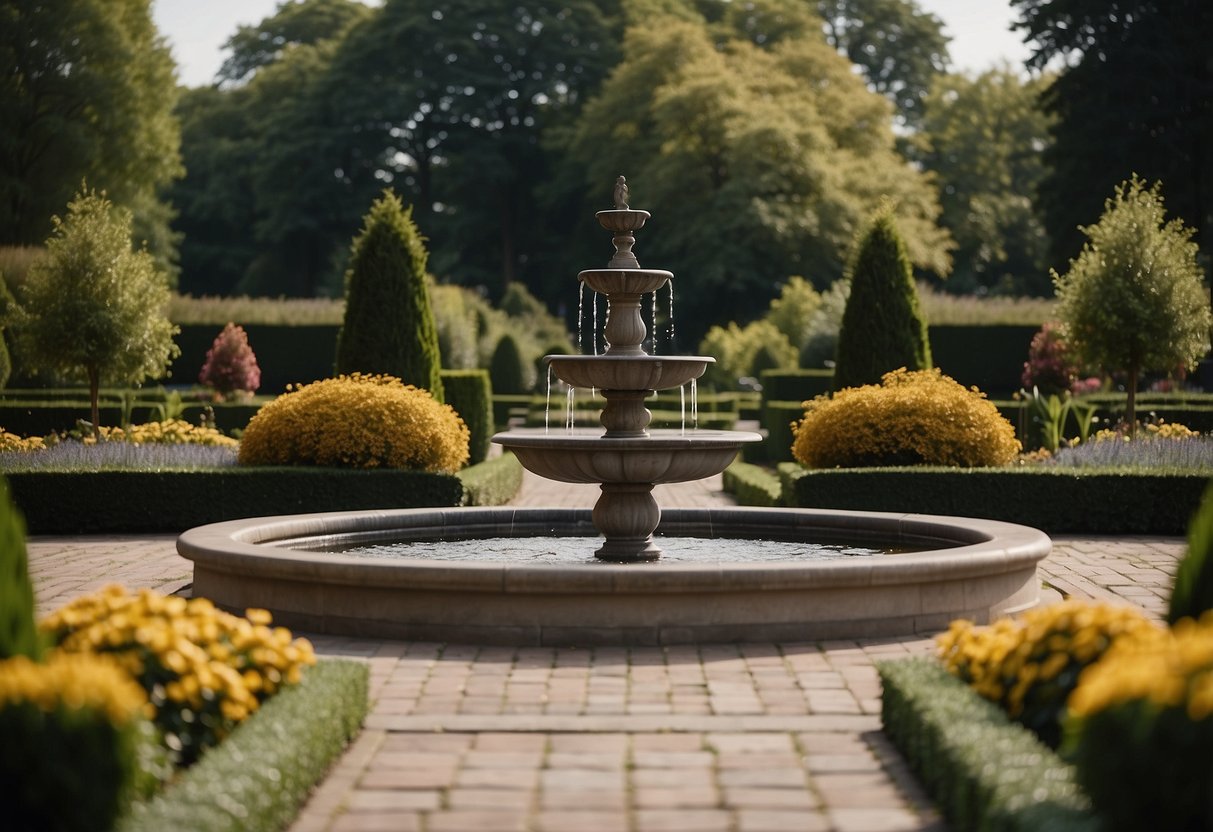
Symmetrical gardens rely on balance and harmony to create a pleasing visual effect. The key points to focus on are how to achieve symmetry, the right color schemes to use, and suitable plant choices.
Principles of Symmetry
Symmetry in garden design means mirroring elements on either side of a central line. This could be a path, garden bed, or structure.
Both sides should be identical or balanced in shape, size, and placement. Structures such as benches, fountains, or even trees can help anchor the symmetry.
The goal is to create a sense of order and peace. Use geometrical shapes like circles, squares, and rectangles. These shapes can easily reflect each other.
Even subtle asymmetries, like placing a larger plant near smaller ones, should look balanced. This often requires careful planning and observation.
Color Schemes for Symmetry
Choose colors that can be balanced easily across the garden space. Monochromatic schemes using different shades of one color can be very effective.
Contrasting colors can also work, provided they are evenly distributed. If you have a blue flower on one side, ensure there’s an equally vibrant plant on the opposite side.
Seasonal changes can affect the balance. Maintain symmetry with perennials that bloom at the same time on both sides.
Foliage color is as important as flower color. Having similar colored leaves on either side can help maintain the symmetrical look even when plants are not in bloom.
Basic Plant Selection
Opt for plants that grow evenly and require similar care. This ensures both sides of the garden develop uniformly.
Common choices:
- Boxwood
- Lavender
- Rose bushes
Use plants with symmetrical growth habits. For example, topiary is great for adding neat and visually appealing symmetry to gardens.
Mix different plant heights and textures, but make sure the combinations are mirrored on both sides. Groupings should invoke a mirror image effect without breaking the balance.
Consider how plants will mature. Fast-growing plants might outpace slower ones, disrupting symmetry. Choose wisely to maintain balance over time.
Creating Focal Points
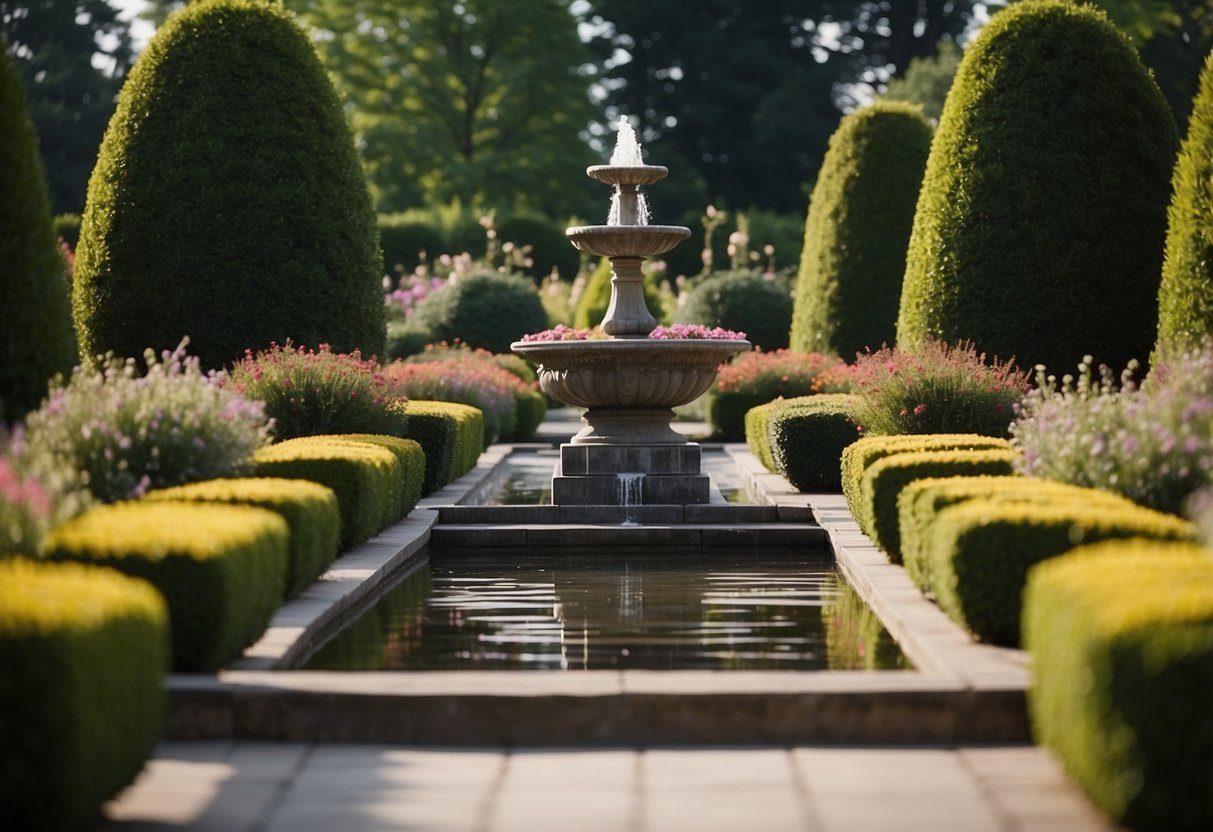
In symmetrical garden design, creating focal points helps draw the eye and establish balance. This can be achieved using statues, water features, and pathways, each offering unique benefits.
Using Statues and Sculptures
Statues and sculptures are excellent focal points for a symmetrical garden. Placing a statue at the center or ends of a path creates a striking visual anchor. Choose a simple, elegant design to maintain the garden’s balance. For example, an obelisk or a classical figure can work well.
Materials play a role too, with stone and metal being popular choices for their durability and aesthetic. Consider matching themes: if you have a classic garden, a marble statue may be ideal.
Position these features thoughtfully. Symmetrical placement on either side of a path or around a central axis adds harmony and coherence to your garden’s design.
Water Features
Water features, such as fountains or small ponds, are also great for creating focal points. A centrally located fountain instantly draws the eye and can serve as a soothing auditory element in your garden.
Choose a style that complements your garden. Classical tiers for a traditional look or a modern design for a contemporary garden. Keep the size proportional to your space to avoid overwhelming your garden.
Positioning is crucial. Place the water feature where it can be viewed from multiple angles, enhancing the overall symmetry of your garden.
Symmetrical Pathways
Symmetrical pathways guide the eye and enhance the structured beauty of your garden. Creating pathways that mirror each other on either side of a central axis underlines the symmetry.
Materials like brick, cobblestone, or even gravel can be used to create structured and aesthetically pleasing paths. Consider lining them with identical plants or hedges to reinforce the symmetry.
Paths should lead to significant garden elements like statues, a gazebo, or a central bench. This not only creates focal points but also encourages movement through the space, allowing you to fully enjoy your garden’s design.
Maintaining a Symmetrical Garden
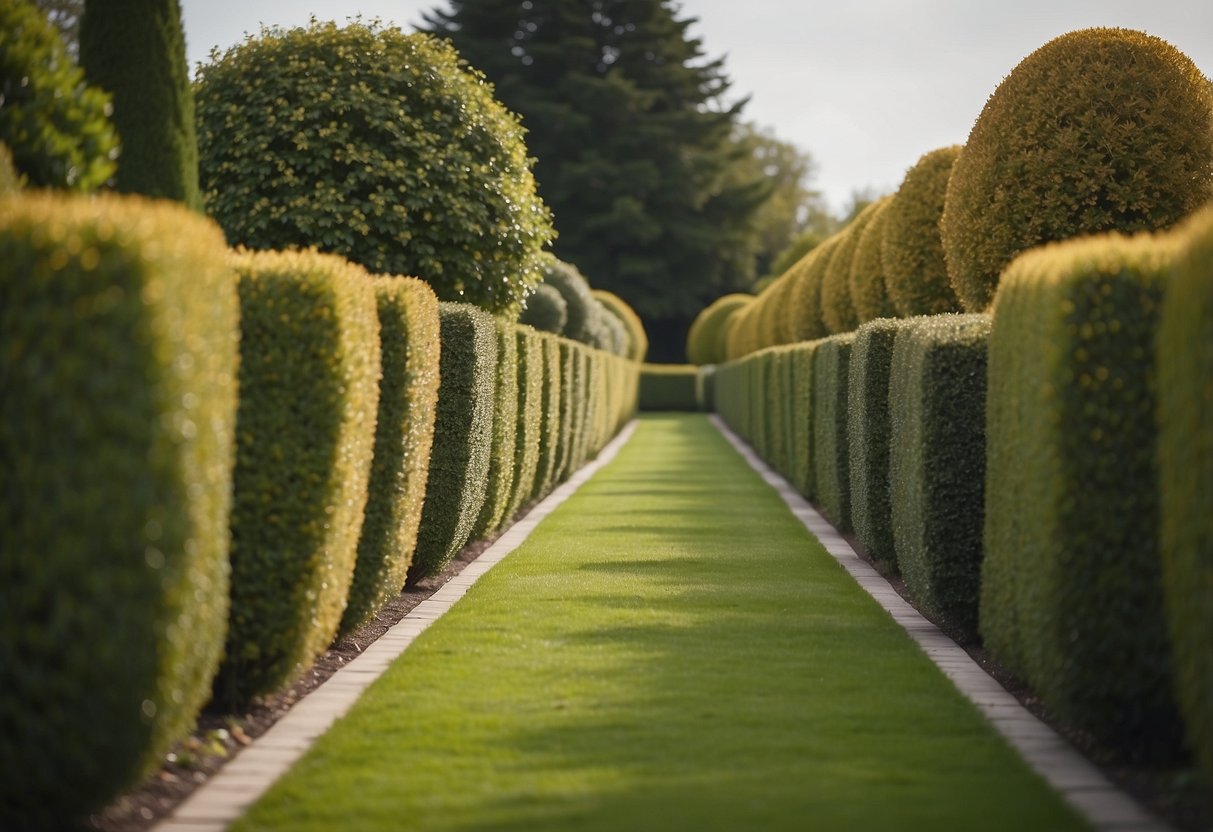
Maintaining symmetry in your garden requires diligence and attention to detail. Focus on proper pruning, making necessary adjustments each season, and using the right soil and fertilizers to keep your plants balanced and healthy.
Pruning Techniques
When maintaining a symmetrical garden, pruning is essential. Regular pruning helps control the shape and size of your plants.
Always use sharp, clean tools to avoid damaging your plants. Start by cutting away dead or diseased branches. Aim for a consistent shape on both sides.
For shrubs and small trees, prune to encourage growth in the desired direction. This can help maintain balance. For instance, if one side of a shrub is growing faster, you can trim it back more heavily to encourage even growth.
Don’t forget to prune flowering plants after their blooming period. This keeps them looking neat and prevents one side from becoming too heavy with spent blooms.
Seasonal Adjustments
Seasonal changes affect a symmetrical garden. During each season, inspect your garden and make necessary adjustments.
Spring is a good time to plant new specimens. Choose plants that complement each other in size, color, and growth habit. Make sure to position them symmetrically around a central point or along a path.
In summer, water regularly and remove any faded flowers. Pay attention to rapid growth and trim as needed.
Fall is ideal for dividing perennials. This can help fill in gaps where plants might have died or become too sparse. Lastly, mulch around your plants to insulate roots during winter.
Winter involves less active work but don’t neglect it. Protect your garden from snow and frost damage. You can use burlap or other coverings to shield sensitive plants and maintain their shape.
Soil and Fertilization Tips
Balanced soil contributes to maintaining symmetry. Test your soil periodically to understand its pH and nutrient content.
Amend the soil with compost to improve its structure and fertility. This encourages even growth across your garden. Choose a balanced fertilizer that matches your plants’ needs, typically denoted by an equal ratio of nitrogen, phosphorus, and potassium (e.g., 10-10-10).
Apply fertilizer evenly, ensuring both sides of your garden get the same treatment. This prevents one side from growing faster than the other, maintaining the desired symmetry.
Water your garden deeply but infrequently. Deep watering encourages roots to grow evenly throughout the soil. This stabilizes your plants and helps them maintain their intended shape and position.







